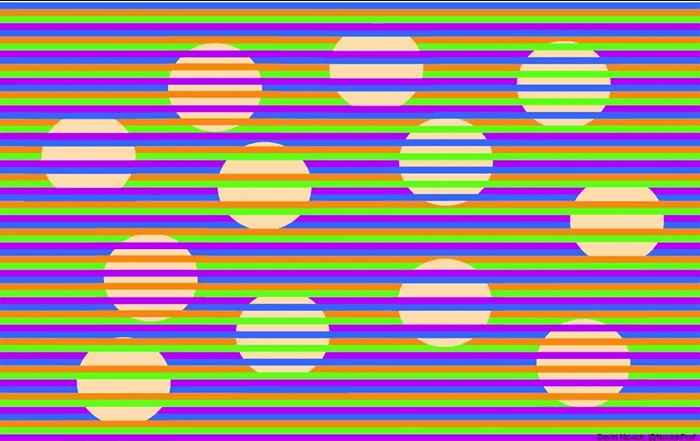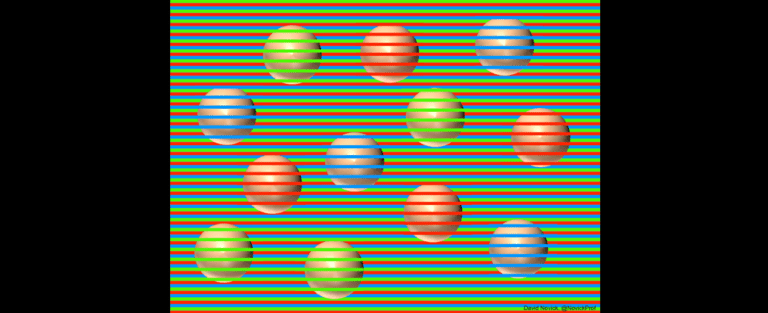See Those Colorful Balls? Yeah, They’re All Actually Beige
These suspending circles may seem red, purple or green from the start, however in reality, each of the 12 spheres are a similar boring shade of beige.
Contracting the picture misrepresents this deception, while zooming in limits the impact, as indicated by David Novick, the maker of the picture and an educator of designing schooling and initiative at the University of Texas at El Paso.
Be that as it may, for what reason do we see the circles as anything other than their genuine nature, beige?
This slanted discernment comes from a marvel known as the Munker-White figment, Novick disclosed to Live Science.
Generally, the fantasy works in light of the fact that “our keenness for shape is superior to our sharpness for shading, which implies that we see the shapes with more detail and the tones with less detail,” Novick said.
Along these lines, while the layouts of the circles all seem indistinguishable, as they are, “the shading kind of seeps over, or absorbs, to adjoining spaces,” Novick said.
In particular, the shade of the circles gets “pulled” nearer to the shade of the stripes getting over them, in the closer view. In this specific picture, called “Confetti Spheres 5,” a variety of green, red and blue stripes cut across the circles and twist our impression of their genuine shade.
The figment depends on the shade of the frontal area stripes, not the shadings behind the scenes behind the circles. In this way, in the event that you eliminate the befuddling stripes, the dream vanishes, leaving just indistinguishable beige balls.
Your image, with all colours whose Lab color distance from (RGB) #f5c882 is in the 20th percentile or greater, replaced by #ffffff. pic.twitter.com/3iSN8P2ZEE
— Jon Seymour (@jonseymour) June 15, 2019
The fantasy works correspondingly when you convert the entirety of the tones to grayscale. Indeed, “White’s fantasy,” in confinement, alludes to the apparent changes in the delicacy of a shape – going from white to dark – brought about by the softness of shapes covering it, as per a 2010 report distributed in the diary Color: Design and Creativity.
For example, when you run white stripes over a dim square shape, the dim seems lighter, or nearer to white; yet when you run dark stripes over a similar square shape, it seems hazier, or nearer to dark.
Analyst Michael White got known for depicting this impact during the 1960s. Also, in 1970, Hans Munker, another therapist, exhibited a comparable impact with shaded shapes and stripes, in which the frontal area stripes twist the apparent tint of the foundation shape, as per the 2010 report.
Researchers have contending hypotheses about what’s going on in the cerebrum to cause this change in discernment. Some think the hallucination sets in right on time during visual preparing, when light first hits the retina, while others think the impact grabs hold later as the cerebrum measures the information. It very well may be a blend of both, the 2010 report notes.
Whatever the specific reason for the hallucination, it’s enjoyable to play with, Novick said. By altering both the gentility and the shade of the closer view stripes, you can “enhance” the clear shading change, causing the foundation shapes to appear to be fiercely unique from their real nature.
All things considered, “it’s a lot simpler to get contrasts in obvious shadings for certain tones than others,” Novick noted. For example, if the foundation shape and frontal area stripes are reciprocal tones (contrary energies on the shading wheel), like red and green, their tones will really offset, so the circles will wind up looking white or dark all things considered, he said.
Novick is as of now contemplating which shading blends create the biggest clear change in the shade of the foundation shape to amplify the impacts of the fantasy.
Also, he and his associate Akiyoshi Kitaoka, a brain science educator at Ritsumeikan University in Kyoto, Japan, are contrasting what the Munker-White figment means for 3D shapes, as in “Confetti Spheres 5,” when contrasted with level, 2D shapes.

“The deception appears to be more detectable, or striking, with the circles instead of the level plates. Furthermore, we don’t have the foggiest idea why,” Novick said. “Now, I don’t figure anyone does.”
Novick was initially propelled to create hallucinations subsequent to seeing and finding out about Kitaoka’s work. Kitaoka’s site hits the dance floor with clear examples that seem to whirl and undulate as you gaze at them; text along the highest point of the page cautions, “Should you feel dazed, you would do well to leave this page right away.”
After considering these confusing deceptions, Novick got keen on collapsing them into his own examination program on human-PC communication.
In summer 2017, he started making new forms of the hallucinations all alone and, for the sake of entertainment, presented some on his Twitter account. One of these posts – a 2D adaptation of the confetti deception – went “startlingly popular” on July 18, 2018.
“I previously found out about this when my significant other came in and said, ‘You’re in the paper in England,'” Novick said, taking note of his amazement.
Right up ’til the present time, Novick tweets around two new dreams every week, and his more seasoned posts intermittently get rediscovered, become a web sensation and in some cases make the news, he said.




2 Comments